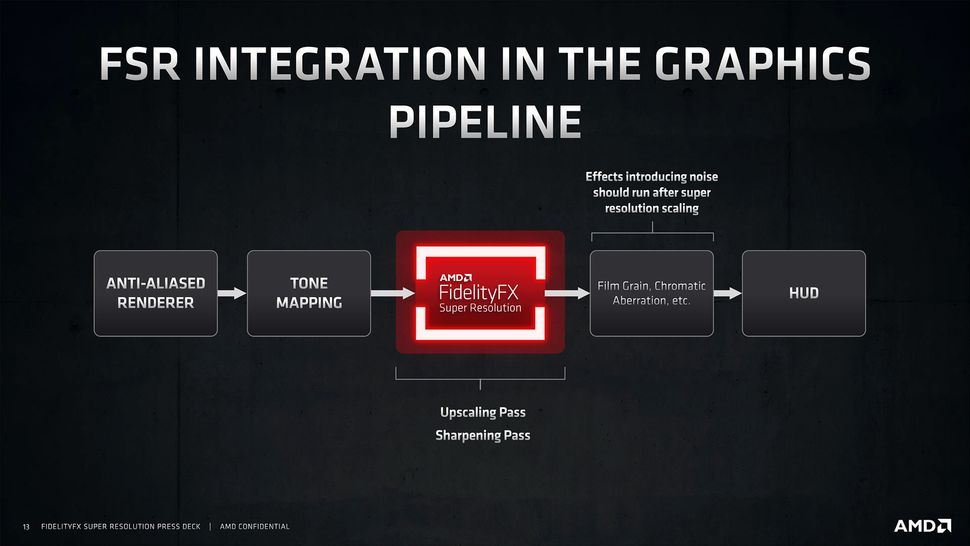What’s the meaning of FidelityFX Super Resolution? AMD FSR explained.
What Is AMD FSR? FidelityFX Super Resolution Explained : Read more
What Is AMD FSR? FidelityFX Super Resolution Explained : Read more
FSR is part of the rendering process, it's no different than if you added, for example, Sonic Ether's shader mods.So then how does this work in conjunction with FreeSync? Say I have a 144Hz FreeSync monitor. Will FreeSync and FidelityFX cooperate to give me a smoth 144 FPS experience, or will they each do their own thing and let whatever happens happen? It seems to me that there is an opportunity for some kind of benefit or efficiency here, but I don't know enough to put my finger on it.

What's an "ideal FreeSync refresh rate"?But if I were an engineer or a manager at AMD I would say to myself, huh... there is an opportunity to make life easier and better for AMD customers by having the FSR software look to see if the user had a FreeSync monitor activated and then tune FSR to give the user the best possible image given the ideal FreeSync refresh rate for their monitor and GPU combination.
What is not explained is how motion will affect this upscaling. All the examples are looking great when we are upscaling static pictures.What’s the meaning of FidelityFX Super Resolution? AMD FSR explained.
What Is AMD FSR? FidelityFX Super Resolution Explained : Read more
That's what makes the DLSS "special" - it maintains fidelity even during fast moving scenes, like the ones that happen all the time in games.FSR uses spatial upscaling using only the source image, while DLSS feeds a neural network through multiple inputs: the source image, motion vectors, temporal feedback from prior frames and the results of its training algorithm.
That would be the max refresh rate of that monitor. My monitor can do 42-60Hz FreeSync, but I really want to use 60 Hz in all the games. FreeSync/G-Sync was a round-about way of still playing a game at high resolution, on a system that is marginally adequate (rendering games at about 45-50FPS). FSR/DLSS do away with that, pushing all the framerates above that.ideal FreeSync refresh rate
I get that FSR is technically a separate technology from FreeSync and they are not directly related. But if I were an engineer or a manager at AMD I would say to myself, huh... there is an opportunity to make life easier and better for AMD customers by having the FSR software look to see if the user had a FreeSync monitor activated and then tune FSR to give the user the best possible image given the ideal FreeSync refresh rate for their monitor and GPU combination. Yes, a person with the right know how might be able to set that up manually, but then again they may not because it may require instantaneous "on the fly" adjustments that only software could make during actual gameplay due to the intensity of the scene and the given FPS at that moment. I'd expect AMD be able to make this happen behind the scenes. After all, their Ryzen CPUs and 6000 series GPUs work in concert using their Smart Access Memory feature. It may be marketing hype or it may be truly beneficial but at least they are giving us a reason to combine the two.
That's already possible. Any game which uses variable shading to maintain a specified performance level can use FSR as well to make the lower-resolution portions look better. The tools are there for a game to do exactly what you describe.I get that FSR is technically a separate technology from FreeSync and they are not directly related. But if I were an engineer or a manager at AMD I would say to myself, huh... there is an opportunity to make life easier and better for AMD customers by having the FSR software look to see if the user had a FreeSync monitor activated and then tune FSR to give the user the best possible image given the ideal FreeSync refresh rate for their monitor and GPU combination. Yes, a person with the right know how might be able to set that up manually, but then again they may not because it may require instantaneous "on the fly" adjustments that only software could make during actual gameplay due to the intensity of the scene and the given FPS at that moment. I'd expect AMD be able to make this happen behind the scenes. After all, their Ryzen CPUs and 6000 series GPUs work in concert using their Smart Access Memory feature. It may be marketing hype or it may be truly beneficial but at least they are giving us a reason to combine the two.

